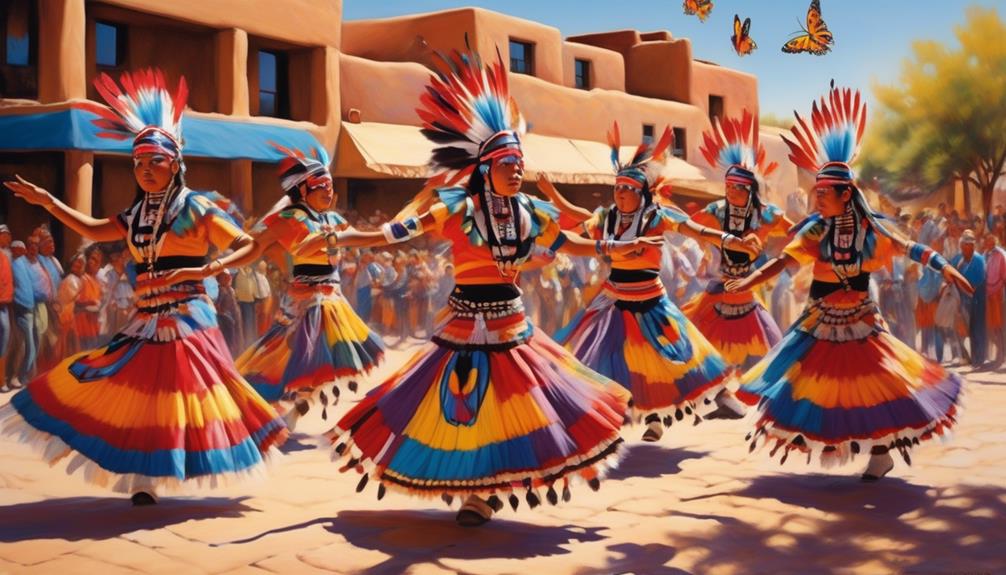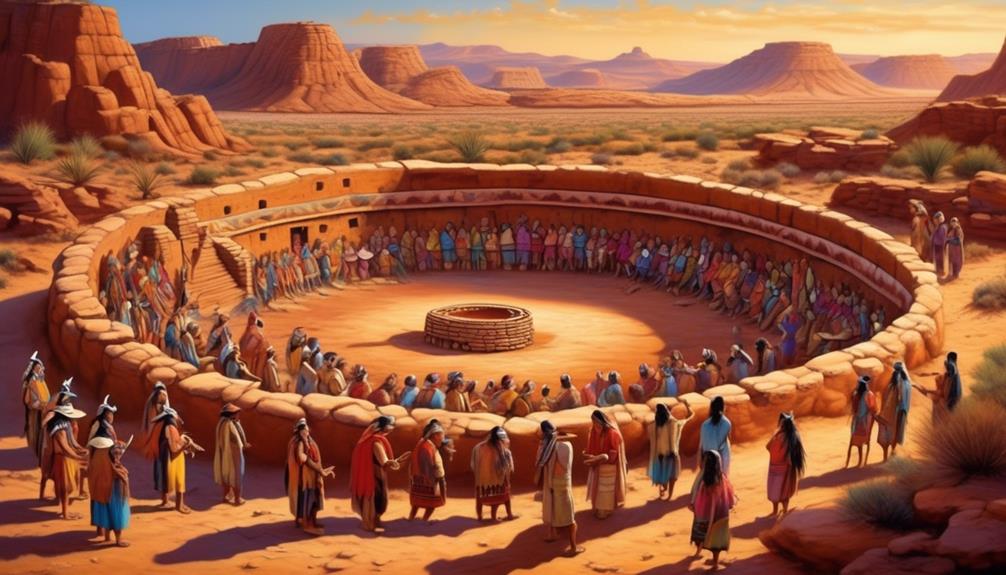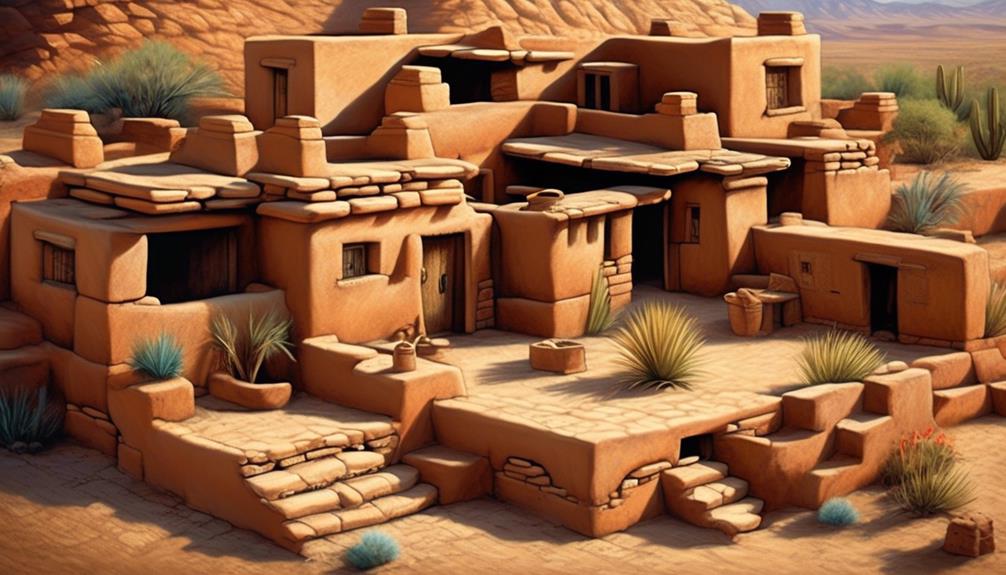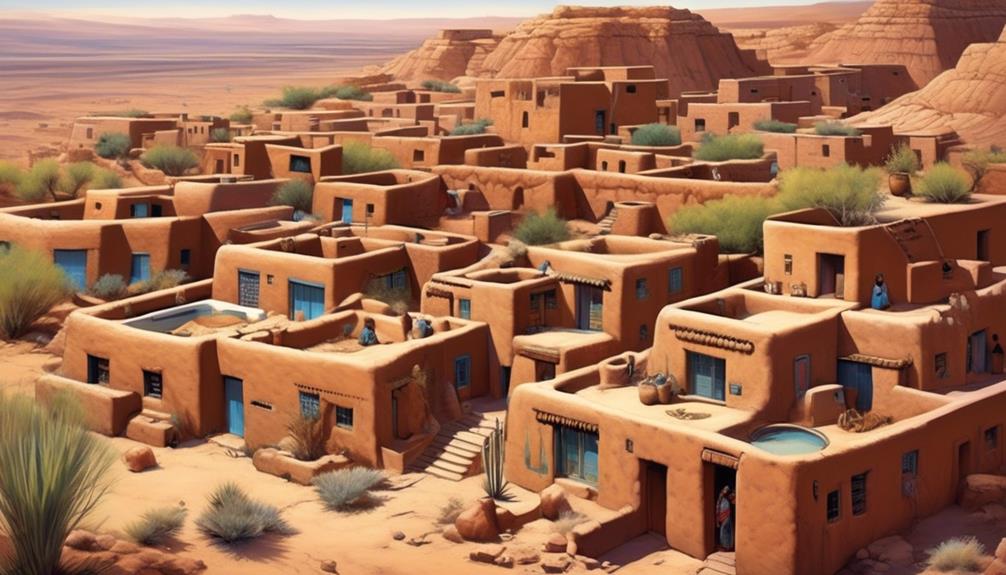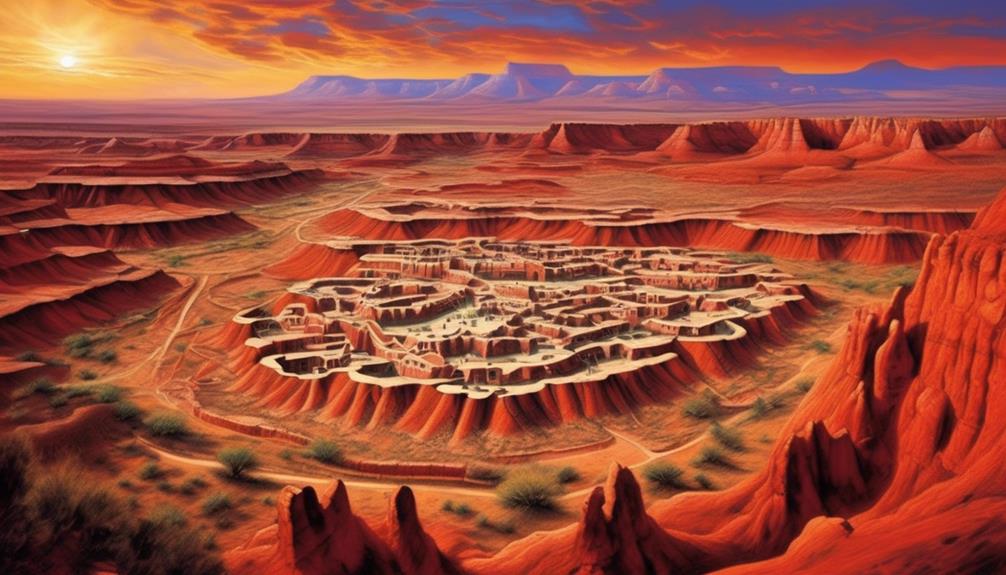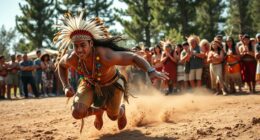Have you ever questioned how the Hopi tribe has managed to flourish in the dry desert of the American Southwest? Despite various theories and speculations, the actual answer is even more fascinating.
From their unique agricultural practices to their deeply spiritual ceremonies, the Hopi tribe has a rich and complex history that has contributed significantly to their enduring cultural identity.
As we explore the facets of their daily lives, we will uncover the fascinating traditions and customs that have shaped the Hopi tribe for generations.
Key Takeaways
- The Hopi tribe practices sustainable farming methods rooted in cultural traditions, such as terraced farming techniques and crop rotation, which reflect their respect for the environment.
- Hopi spiritual ceremonies, including Kachina Dances and Prayer Rituals, are conducted at sacred sites and honor ancestral spirits while seeking rain, fertility, and prosperity.
- The Hopi tribe is known for their traditional crafts, such as hand-coiled pottery, basket weaving, Katsina Dolls, and silver jewelry, which preserve cultural identity and artistic legacy.
- The Hopi clan structure plays a significant role in preserving and transmitting traditional knowledge and traditions, ensuring order, representing interests, and resolving conflicts within the community.
Hopi Agricultural Practices
The Hopi people have developed a unique and sustainable agricultural system that's deeply rooted in their cultural traditions and connection to the land. Sustainable farming is at the heart of the Hopi agricultural practices.
The arid environment of the Hopi reservation presents significant challenges for farming, particularly in terms of water conservation. Despite this, the Hopi have ingeniously developed methods to efficiently utilize water for their crops. They employ terraced farming techniques that capture and retain water, allowing it to percolate into the soil rather than run off. This not only conserves water but also prevents soil erosion.
Additionally, the Hopi have a deep understanding of crop rotation and soil fertility, ensuring that their farming practices remain sustainable for generations. Their agricultural methods reflect a profound respect for the environment and a holistic approach to farming that considers the long-term impact on the land.
The Hopi agricultural practices serve as a testament to the ingenuity and resourcefulness of this ancient culture.
Hopi Spiritual Ceremonies
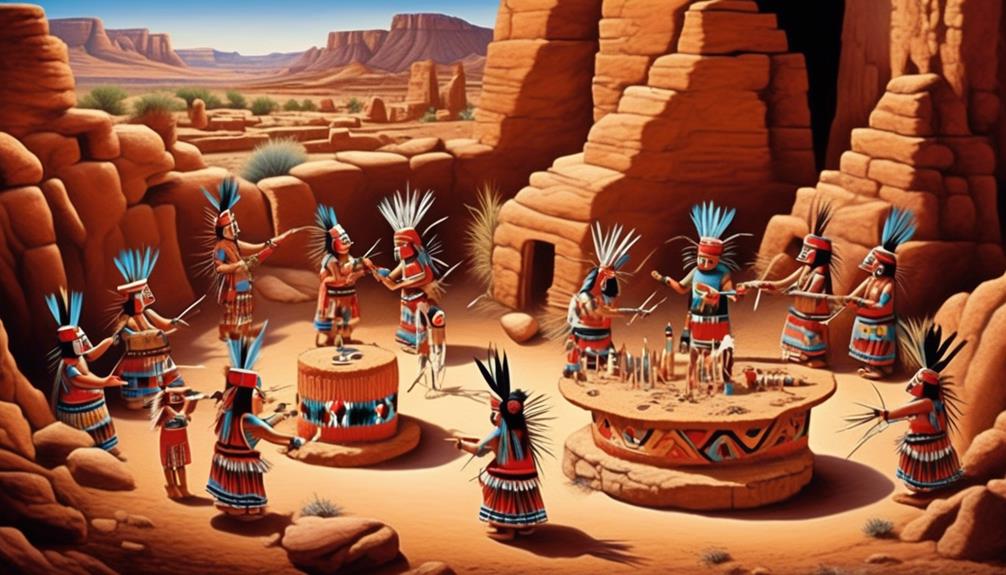
Rooted in their deep cultural traditions and connection to the land, the Hopi people engage in spiritual ceremonies that are integral to their way of life. These ceremonies play a crucial role in maintaining the balance and harmony of the universe, as perceived by the Hopi.
Here are some key elements of the Hopi spiritual ceremonies:
- Hopi Kachina Dances: The Hopi people perform intricate dances to honor the Kachinas, who are revered as ancestral spirits and messengers of the deities. These dances aren't merely for entertainment but are deeply spiritual and are believed to bring rain, fertility, and prosperity to the community.
- Hopi Prayer Rituals: Prayer is an essential component of Hopi spiritual ceremonies. The Hopi offer prayers for rain, good harvests, and overall well-being. These rituals often take place in sacred sites, such as specific mesas and springs, which are believed to hold great spiritual power.
- Hopi Sacred Sites and Ceremonial Clothing: The Hopi conduct their ceremonies at various sacred sites, including kivas, which are underground chambers used for spiritual rituals. Additionally, the ceremonial clothing worn during these events is adorned with intricate symbols and designs that hold deep spiritual significance.
The Hopi spiritual ceremonies are a testament to the tribe's profound connection to their cultural heritage and the natural world.
Hopi Traditional Crafts
Incorporating intricate designs and age-old techniques, the Hopi people's traditional crafts reflect a profound connection to their cultural heritage and the natural world. The craftsmanship techniques passed down through generations are evident in the artistic expressions of pottery, basket weaving, katsina doll carving, and silver overlay jewelry. These crafts are not merely decorative but hold deep spiritual and cultural significance for the Hopi tribe.
| Craft | Description |
|---|---|
| Pottery | Hand-coiled and painted with intricate geometric patterns and symbolic imagery. |
| Basket Weaving | Woven from natural materials like rabbit brush and sumac, often depicting spiritual motifs. |
| Katsina Dolls | Intricately carved wooden dolls representing ancestral spirits and deities. |
| Silver Jewelry | Characterized by delicate etching and overlay techniques, often featuring traditional symbols. |
Each craft embodies the Hopi people's respect for the land, their ancestors, and the spiritual forces that govern their lives. The attention to detail and the preservation of traditional methods in these crafts serve as a testament to the tribe's enduring cultural identity and artistic legacy.
Hopi Clan Structure
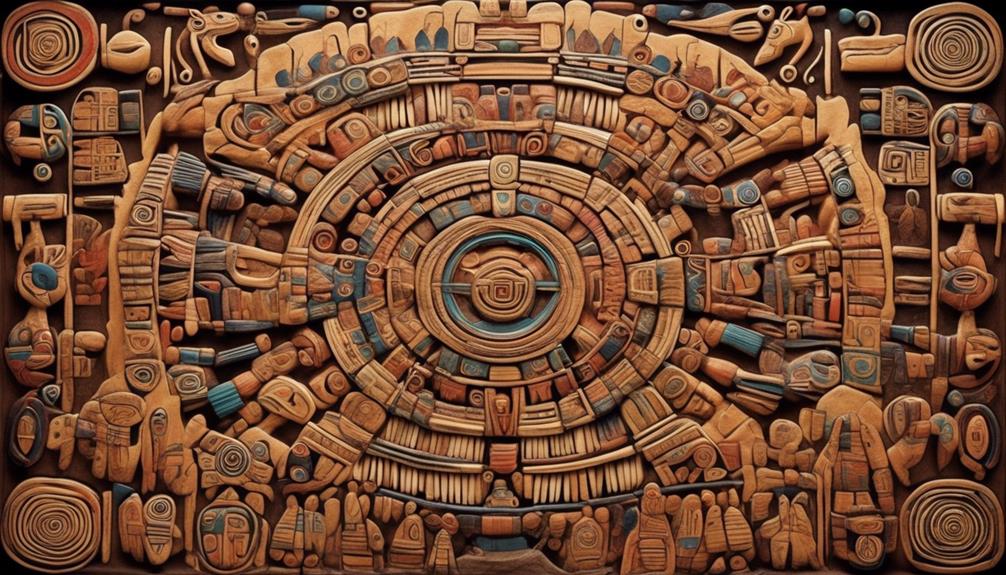
Evident in the social fabric of the Hopi tribe is a complex and enduring clan structure that plays a fundamental role in shaping their cultural identity and communal relationships. The Hopi clan structure is a vital aspect of their societal organization, and it's characterized by the following key elements:
- Clan Leadership: The Hopi clans are led by a chief, who's responsible for maintaining order within the clan and representing its interests in the broader tribal community. The chief's role is crucial in decision-making processes and conflict resolution, ensuring the cohesion and well-being of the clan.
- Kinship Relationships: The clan structure is deeply rooted in kinship relationships, forming the foundation of Hopi social organization. Kinship ties dictate familial responsibilities, inheritance, and ceremonial practices, fostering a strong sense of unity and mutual support within and across clans.
- Cultural Identity: Each clan possesses distinct ceremonial knowledge, traditions, and sacred practices that contribute to the rich tapestry of Hopi cultural heritage. The clan structure serves as a vehicle for the preservation and transmission of traditional knowledge, reinforcing the tribe's cultural identity and continuity across generations.
The intricate web of clan relationships and leadership dynamics underscores the significance of the clan structure in shaping the Hopi tribe's social fabric and cultural legacy.
Hopi Oral Traditions
Drawing upon centuries of storytelling and communal wisdom, Hopi oral traditions form an integral part of our cultural heritage and serve as a repository of knowledge and values passed down through generations.
The Hopi storytelling techniques are rich and diverse, incorporating vivid imagery, symbolism, and allegory to convey moral lessons, historical accounts, and spiritual beliefs. Through oral narratives, the Hopi people maintain a profound connection to their ancestors and the natural world, fostering a deep sense of identity and belonging within the community.
The preservation of these oral traditions is paramount to the continuity of our cultural legacy. Efforts to revitalize the Hopi language, a fundamental aspect of transmitting these traditions, have seen a positive impact on the preservation of our oral heritage. By safeguarding the language, we ensure that the nuances and intricacies of our stories and teachings are faithfully passed on to future generations.
The revitalization initiatives not only help in preserving the linguistic heritage but also play a crucial role in maintaining the integrity of our oral traditions, affirming their significance in shaping the collective consciousness of the Hopi people.
Frequently Asked Questions
How Did the Hopi Tribe Interact With Other Native American Tribes in the Region?
We noticed the Hopi tribe's intertribal relations were marked by mutual respect and cultural exchange. They engaged in trade, alliances, and ceremonial gatherings with neighboring tribes, fostering a rich tapestry of traditions.
This interaction influenced art, religious practices, and social customs, reflecting a deep interconnectedness.
The Hopi's commitment to peaceful coexistence and collaboration with other tribes exemplifies the value they placed on preserving their heritage while embracing the diversity of Native American cultures.
What Are the Traditional Gender Roles Within the Hopi Tribe?
In traditional Hopi culture, gender roles are deeply rooted in the social dynamics of the community. Traditional roles dictate specific responsibilities for both men and women, shaping the fabric of our society.
These roles aren't just tasks, but reflections of our cultural values and beliefs. The interplay of these roles creates a harmonious balance, contributing to the resilience and cohesion of our tribe.
How Has Modernization and Outside Influence Impacted the Hopi Tribe's Traditional Way of Life?
Modernization and outside influence have significantly impacted the Hopi Tribe's traditional way of life. The impact of modernization has led to a shift in traditional practices, challenging the preservation of our cultural heritage.
Outside influence has also affected our community integration and spiritual beliefs. While we strive to maintain our traditions, the pressures of the modern world present ongoing challenges.
It's essential for us to find a balance between preserving our culture and adapting to the changing world.
What Role Do Animals and Nature Play in Hopi Spirituality and Daily Life?
Nature reverence and spiritual connection are central to our daily life and spirituality.
Animals and nature hold great significance in our culture, symbolizing our interconnectedness with the natural world.
We observe and honor the rhythms of nature, finding spiritual guidance and strength in its cycles.
Our rituals and ceremonies often involve animal and nature symbolism, reflecting our deep respect and reliance on the natural world for sustenance and guidance.
How Does the Hopi Tribe View and Practice Leadership Within Their Community?
Observing the Hopi tribe's leadership structure and community decision-making, it's evident that their system is deeply rooted in traditional values. The leadership positions are often earned through wisdom, experience, and a profound understanding of the community's needs.
Community decisions are made through consensus, where each member's perspective is valued and considered. This inclusive approach fosters a strong sense of unity and ensures that the collective well-being is prioritized in all aspects of governance.
Conclusion
As we reflect on the Hopi tribe, we can't help but feel a sense of wonder and admiration for their enduring traditions and deep connection to the land.
Their agricultural practices, spiritual ceremonies, traditional crafts, clan structure, and oral traditions all serve as a testament to their rich cultural heritage.
The Hopi tribe's resilience and commitment to their customs leave us eager to learn more about their fascinating way of life.
Mary is a passionate writer who brings creativity and a fresh perspective to our team. Her words have the power to captivate and inspire, making her an essential contributor to our content. Mary’s commitment to storytelling and dedication to promoting Indigenous culture ensures that her work touches the hearts of our readers. We’re fortunate to have her as part of our team.
